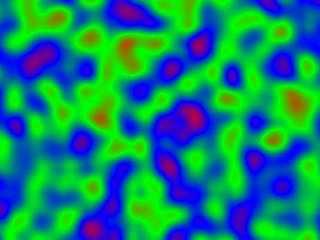|
 |
Warp wrote:
>
> If you want each color component to cover the same percentage of the pigment,
> you'll have to set it up so that each of them gets 33.33% of it. For example:
>
> [ 0/3 rgb Red ]
> [ 1/3 rgb Green ]
> [ 2/3 rgb Blue ]
> [ 3/3 rgb Red ]
>
> Now you have an equal amount of each color (ie. 33.33% of each). This should
> work with every pattern which has even distribution.
>
See the attached result: there is much less red than any of
the others, so this isn't the correct behavior either...
> Multiplying the function with a scalar only changes its amplitude, not
> its shape. Your non-linear transformation makes it a completely different
> function.
>
Both make it a completely different function then. The only
meaningful way yet devised to compute how much two function
f and g differ is to integrate abs(f()-g()) (or some
variants involving exposants). Using that distance, my
function is less different than Nathan's from either the
truncated or the non truncated original functions
> Nope. The curvature of the surface in some places is higher in your
> function than in the old one (if we don't count the plateaus produced by
> the clamping). This makes it less smooth.
> A sphere is smoother than an ellipsoid.
>
You can't really talk about the curvature of a function
that goes from 3D space to 1D... If you want to speak about
the curvature of the isosurfaces of this function, they are
the same as for the old one (possibly less but certainly not
more) and Nathan's has the same behavior too. If you want to
speak about the second order derivatives, I agree that mine
can be more than the non-truncated function but not by much
whereas Nathan's are *a lot* less...
> Nathan's function is _exactly_ the same as the old one. Only the amplitude
> has changed.
See above...
> A sine wave does not stop being a sine wave if we multiply it by a scalar.
> However if we make a non-uniform transform to it, then it stops being a
> sine wave.
That's only a matter of the way a sine-wave has been
defined. Add two polynomials and you get a polynomial, add
two sine waves and you won't always get a sine-wave. Noise3d
is neither a sine-wave (nor a polynomial) so you can't apply
the same rules to it (for example add two noise3ds, what do
you get? I think you get another noise3d, so the strict sine
wave rules don't apply).
> As I said that happened only because your color_map was in favor of the
> green value (50%) and not the others (25% each).
>
The attached pic uses the color_map which you said was
evenly distributed and yet the red is not very present.
Again, I say that Nathan's function is biased towards the
middle values (I'll concede that mine and the old one are
probably biased towards the sides, but Nathan's is no more
correct)
> Wrong. Nathan's fix did not change the function. Yours did. Your function
> is thus a different one.
Again, I say that my function is no more different than
Nathan's and probably even less so.
This isn't going anywhere. I think we should define what
exactly we expect from a noise3d function before we can
start arguing over which one does it better (or whether we
should change it completely). My goal was to change the
original function (plateaus and all) as little as possible
while getting rid of the plateaus, and in this regard it
obviously succeded better than Nathan's. But if we don't
decide first on what the correct behavior should be (without
relation to the old one since the plateaus obviously weren't
correct behavior) we can't really argue over wich is
better...
Jerome
--
* Doctor Jekyll had something * mailto:ber### [at] iname com
* to Hyde... * http://www.enst.fr/~jberger
******************************* com
* to Hyde... * http://www.enst.fr/~jberger
*******************************
Post a reply to this message
Attachments:
Download 'noise3d.jpg' (12 KB)
Preview of image 'noise3d.jpg'

|
 |




![]()